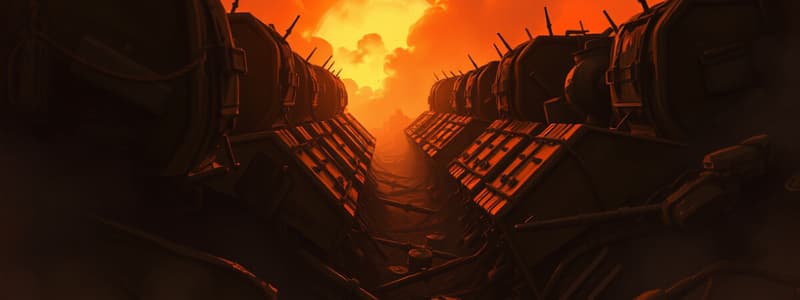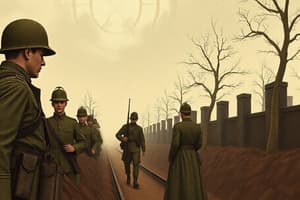Podcast
Questions and Answers
The two opposing sides in the war were the Allies and the ______ Powers.
The two opposing sides in the war were the Allies and the ______ Powers.
Central
The ______ entered the war in May 1915 on the side of the Allies.
The ______ entered the war in May 1915 on the side of the Allies.
Italy
The USA entered the war in ______ 1917.
The USA entered the war in ______ 1917.
April
Both sides dug themselves in and spent the next four years attacking and defending lines of ______.
Both sides dug themselves in and spent the next four years attacking and defending lines of ______.
Germany captured ______ by December 1917, forcing the Russians out of the war.
Germany captured ______ by December 1917, forcing the Russians out of the war.
An armistice was signed on 11 November ______.
An armistice was signed on 11 November ______.
The controversial peace settlement was signed at ______ the following year.
The controversial peace settlement was signed at ______ the following year.
The German advance on the western front was initially held up by strong ______ resistance.
The German advance on the western front was initially held up by strong ______ resistance.
The British tried at Neuve Chapelle and Loos, while the French tried in ______.
The British tried at Neuve Chapelle and Loos, while the French tried in ______.
The Germans attacked again at ______.
The Germans attacked again at ______.
Trench warfare presented the same challenges, including barbed wire in ______.
Trench warfare presented the same challenges, including barbed wire in ______.
Reconnaissance ______ and observation balloons were used to spot troop concentrations.
Reconnaissance ______ and observation balloons were used to spot troop concentrations.
The increased firepower of magazine rifles and machine-guns made frontal attacks ______.
The increased firepower of magazine rifles and machine-guns made frontal attacks ______.
Russia faced mixed fortunes, having successes against ______, but defeats against Germany.
Russia faced mixed fortunes, having successes against ______, but defeats against Germany.
The Gallipoli Campaign aimed to clear the Dardanelles and open a supply line to ______.
The Gallipoli Campaign aimed to clear the Dardanelles and open a supply line to ______.
The first attempt at Gallipoli, a naval attack, failed when ships ran into a series of ______.
The first attempt at Gallipoli, a naval attack, failed when ships ran into a series of ______.
The year 1915 was not a good one for the ______; even a British army became bogged down in Mesopotamia.
The year 1915 was not a good one for the ______; even a British army became bogged down in Mesopotamia.
Bulgaria's decision to join the ______ Powers was likely influenced by the war's developments.
Bulgaria's decision to join the ______ Powers was likely influenced by the war's developments.
A Franco-British force landed at Salonika in neutral Greece to try and relieve ______.
A Franco-British force landed at Salonika in neutral Greece to try and relieve ______.
The Italians aimed to seize Austria-Hungary's Italian-speaking provinces and territory along the eastern shore of the ______ Sea.
The Italians aimed to seize Austria-Hungary's Italian-speaking provinces and territory along the eastern shore of the ______ Sea.
The Battle of Verdun was a massive attack launched by the Germans under ______.
The Battle of Verdun was a massive attack launched by the Germans under ______.
The French lost heavily at Verdun, with about ______ men losing their lives.
The French lost heavily at Verdun, with about ______ men losing their lives.
The Battle of the Somme began on ______ July and lasted through to November.
The Battle of the Somme began on ______ July and lasted through to November.
The aim of the Somme was to relieve pressure on the French at Verdun and keep the Germans fully ______.
The aim of the Somme was to relieve pressure on the French at Verdun and keep the Germans fully ______.
On the very first day, 20,000 were killed and 60,000 were ______.
On the very first day, 20,000 were killed and 60,000 were ______.
The real importance of the battle was the blow to German ______.
The real importance of the battle was the blow to German ______.
The Allies made only limited advances varying between a few hundred yards and ______ miles, along a 30-mile front.
The Allies made only limited advances varying between a few hundred yards and ______ miles, along a 30-mile front.
Losses on both sides were appalling, with German casualties amounting to ______ 650,000.
Losses on both sides were appalling, with German casualties amounting to ______ 650,000.
Haig came in for the most serious ______ for the majority of historians.
Haig came in for the most serious ______ for the majority of historians.
One historian, W.J. Laffin, called his book about the war 'British Butchers and ______ of World War 1'.
One historian, W.J. Laffin, called his book about the war 'British Butchers and ______ of World War 1'.
Haig was slow to see beyond the tactic of the '______ push'.
Haig was slow to see beyond the tactic of the '______ push'.
The horrors of the Somme contributed to the fall of British Prime Minister, ______.
The horrors of the Somme contributed to the fall of British Prime Minister, ______.
The Battle of Jutland took place on ______ 1916.
The Battle of Jutland took place on ______ 1916.
The German Admiral von Scheer tried to lure part of the ______ fleet out from its base.
The German Admiral von Scheer tried to lure part of the ______ fleet out from its base.
The Germans lost ______ ships during the Battle of Jutland.
The Germans lost ______ ships during the Battle of Jutland.
The Germans' failed attempt to destroy British sea power led them to embark on ______ submarine warfare.
The Germans' failed attempt to destroy British sea power led them to embark on ______ submarine warfare.
The peak of German success in submarine warfare came in ______ 1917.
The peak of German success in submarine warfare came in ______ 1917.
In April 1917, Britain was down to about six weeks' ______ supply.
In April 1917, Britain was down to about six weeks' ______ supply.
Lloyd George insisted that the Admiralty adopt a ______ system to protect merchant ships.
Lloyd George insisted that the Admiralty adopt a ______ system to protect merchant ships.
The German High Seas Fleet stayed in ______ for the rest of the war.
The German High Seas Fleet stayed in ______ for the rest of the war.
Flashcards are hidden until you start studying
Study Notes
The First World War
- The First World War (1914-1918) pitted the Allies (Britain, France, Russia, Italy, Serbia, Belgium, Romania, USA, Japan) against the Central Powers (Germany, Austria-Hungary, Turkey, Bulgaria).
- Unlike expectations of a short war, the conflict dragged on for four years, largely due to trench warfare on the Western Front which resulted in a stalemate.
- Initial German attempts to quickly defeat France failed, leading to a costly trench warfare that lasted till 1918.
- Eastern Europe saw more movement with initial Russian successes against Austria, but German intervention forced Russia out of the war in December 1917.
- The war turned in favor of the Allies after the US entry in April 1917.
- Germany's last desperate attempt for a decisive breakthrough in France in spring 1918 was unsuccessful.
- The British blockade of German ports and the successful defense of convoys starved the Germans, weakening their position by late summer 1918.
- An armistice was signed on November 11, 1918, concluding the war.
- The Treaty of Versailles, signed in 1919, established a controversial peace settlement.
1914:
Western Front:
- The German advance was initially hindered by strong Belgian resistance, delaying the capture of Brussels.
- Early attempts at breakthroughs by the Allies (British at Neuve Chapelle and Loos, French in Champagne, Germans at Ypres) failed due to the challenges of trench warfare.
- Trench warfare was characterized by barbed wire, aerial reconnaissance, and increased firepower, making frontal attacks incredibly risky and rendering cavalry ineffective.
Eastern Front:
- Russia experienced mixed fortunes, achieving successes against Austria but facing defeats against Germany, leading to the capture of Warsaw and Poland.
- The Turkish blockade of the Dardanelles hampered Russian supplies, further complicating their situation.
The Gallipoli Campaign:
- Launched by Winston Churchill, the Gallipoli Campaign aimed to clear the Dardanelles and alleviate the deadlock on the Western Front.
- The campaign was a failure, with the initial naval attack failing due to mines, and subsequent landings facing stiff Turkish resistance.
- Allied forces were ultimately withdrawn in December, severely impacting morale and representing a missed opportunity to aid Russia via the Black Sea.
Serbia:
- Serbia was overrun by Bulgarians and Germans after Bulgaria joined the Central Powers in October 1915.
- A Franco-British force landed at Salonika in neutral Greece to aid Serbia, but it was too late.
Mesopotamia:
- British forces, tasked with protecting Anglo-Persian oil interests, became bogged down in Mesopotamia while approaching Baghdad.
- They were besieged by the Turks at Kut-el-Amara from December 1915 to March 1916, ultimately forced to surrender.
Italy's Declaration of War:
- Italy, motivated by territorial ambitions, declared war on Austria-Hungary in May 1915.
- The Italians hoped to seize Austrian territories, but their progress was limited and ultimately did not alleviate pressure on the Russians.
1916:
Western Front:
- 1916 witnessed two major battles: Verdun and the Somme.
- The Battle of Verdun saw a massive German offensive aimed at drawing French forces and inflicting heavy losses.
- The French, under Pétain, held their ground, preventing the German advance, but both sides suffered significant casualties.
- The Somme was a series of assaults, mainly by British troops, intended to relieve pressure on Verdun and keep the Germans engaged on the Western Front.
- The battle began disastrously for the British, with heavy losses on the first day, and continued with limited gains despite immense casualties.
- The Somme weakened German morale and underscored Britain's growing military capabilities.
- Despite the horrors of the Somme, Allied generals continued to favor frontal assaults, leading to further heavy casualties.
Naval Warfare:
- The Battle of Jutland (May 31, 1916) was the only major engagement between the main battle fleets of the war.
- It was a tactical German victory, but failed to cripple British sea power.
- The Battle of Jutland marked a shift in German strategy.
Unrestricted Submarine Warfare:
- Germany, facing food shortages due to the British blockade, initiated "unrestricted" submarine warfare in January 1917.
- This campaign aimed to sink all merchant ships in the Atlantic, even neutral ones, risking US entry into the war.
- While initially effective, the British response with a convoy system countered the submarine threat.
Studying That Suits You
Use AI to generate personalized quizzes and flashcards to suit your learning preferences.




